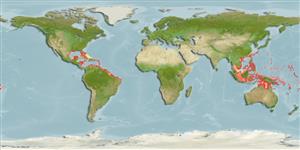Preferred temperature (Ref.
115969): 25 - 29.1, mean 28 (based on 1142 cells).
Phylogenetic diversity index (Ref.
82804): PD
50 = 0.5176 [Uniqueness, from 0.5 = low to 2.0 = high].
Bayesian length-weight: a=0.00617 (0.00458 - 0.00830), b=2.94 (2.86 - 3.02), in cm Total Length, based on LWR estimates for this species (Ref.
93245).
Trophic level (Ref.
69278): 3.5 ±0.3 se; based on diet studies.
устойчивость к внешним воздействиям (Ref.
120179): средний (среднего размера), минимальное время удвоения популяции 1.4-4.4 года (K=0.22-0.3; tm=2).
Fishing Vulnerability (Ref.
59153): High vulnerability (60 of 100).
Climate Vulnerability (Ref.
125649): Very high vulnerability (88 of 100).
